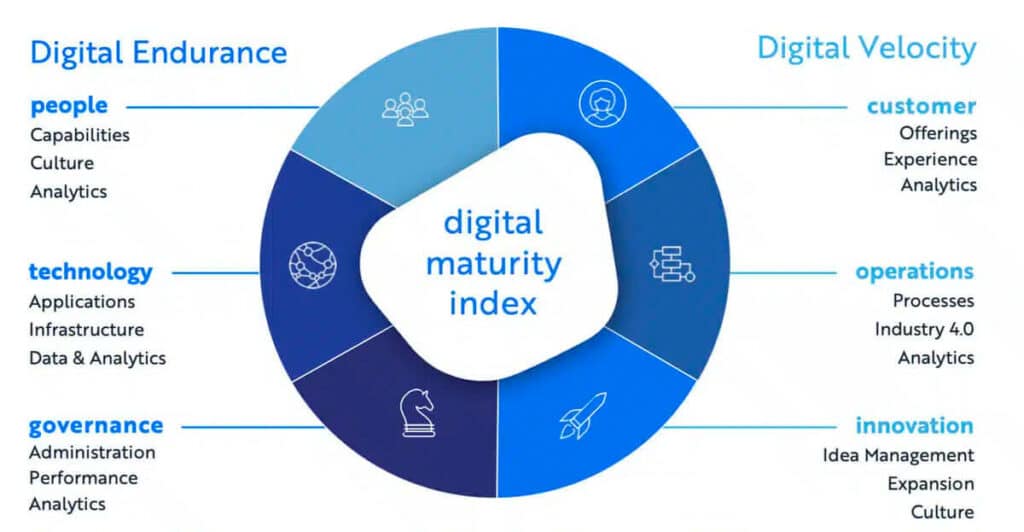Digital Maturity
Digital maturity is a measure of an organisation's readiness and capability to use digital technologies to achieve its business objectives. It refers to the organisation's ability to use digital technologies effectively, integrate them into its business operations, and leverage them to create value for customers and stakeholders.
Digital maturity is not a fixed state but a dynamic process of continuous improvement, and it can vary widely across organisations and industries. A digitally mature organisation is one that has a well-defined digital strategy, a culture of innovation and experimentation, and the ability to attract, develop, and retain digital talent. It also has the ability to optimise its core business processes using digital technologies, and to create new business models and revenue streams based on digital innovation.
To assess their digital maturity, organisations can use frameworks such as the Digital Maturity Index, which assesses maturity across the following six business dimensions: People, Technology, Governance, Customers, Operations, and Innovation.
By measuring and tracking their digital maturity, organisations can identify areas for improvement, set targets for progress, and take action to optimise their digital capabilities and achieve their business objectives. Before we explore each of the six dimensions in more detail, let me clarify the difference between digital maturity and digital transformation, and answer some common questions.

What is the difference between digital maturity and digital transformation?
Digital maturity and digital transformation are related but distinct concepts. Digital maturity refers to the degree to which an organisation has integrated digital technologies and processes into its operations, customer interactions, and innovation activities. It encompasses a range of factors, such as the level of automation and digitisation of key business processes, the degree to which data and analytics are used to inform decision-making, and the level of integration of digital technologies such as robotics, artificial intelligence, and the Internet of Things.
Digital transformation, on the other hand, refers to the process of using digital technologies and processes to fundamentally change the way an organisation operates, creates value, and interacts with customers. Digital transformation involves a comprehensive and strategic approach to using digital technologies to drive innovation, improve operations, and create new value propositions for customers. It often involves rethinking traditional business models, processes, and organisational structures, and may require significant investment in new technologies, skills, and capabilities.
In other words, digital maturity is an indicator of how far along an organisation is in its adoption of digital technologies and processes, while digital transformation is a more comprehensive and strategic effort to leverage digital technologies to drive growth and innovation. While digital maturity can be an important enabler of digital transformation, it is not sufficient on its own, as it may not address fundamental shifts in customer needs, competitive dynamics, and market forces that require a more radical transformation of the organisation.
What are the stages of digital maturity?
Digital maturity models exist for each of the six dimensions, each of which had five levels of maturity. However for the purposes of simplification in this article, we have summarised one overarching maturity model with five levels which are:
Level 1 – Defined
Digital is not a priority yet and the organisation needs to prepare for its digital transformation journey.
Level 2 – Organised
Several digital initiatives are underway. Business process and technology are in a healthy state.
Level 3 – Integrated
Some basic digital capabilities have been developed. Data is recognised as a valuable asset and technology and business processes are well integrated.
Level 4 – Optimised
Digital capabilities are well developed. Customer focus and an innovation mindset are essential to the organisation. Integration is complete, while optimisation and simplification are in progress.
Level 5 – Digital
Customer focus, process optimisation, agile working and innovative culture are well- established. Channels are integrated. Systems are top- level secure. Real- time data is used to run business, predict future scenarios and make simulations.
What are examples of digital maturity?
Here are some examples of digital maturity in different areas of an organisation:
Operations
A digitally mature organisation may have implemented automation and analytics tools to streamline and optimise core business processes, such as manufacturing, supply chain management, and customer service. For example, a manufacturing company might use digital sensors and analytics to monitor production lines in real-time, or a logistics company might use machine learning algorithms to optimise delivery routes and reduce transportation costs.
Customer Centricity
A digitally mature organisation may use digital technologies to create personalised and engaging experiences for customers across multiple touchpoints, such as mobile apps, social media, and chatbots. For example, an e-commerce retailer might use customer data and predictive analytics to offer personalised product recommendations, or a bank might use machine learning algorithms to provide personalised financial advice to customers.
Governance
A digitally mature organisation may have a well-defined digital strategy that is closely aligned with broader business objectives, and clear policies and procedures in place for digital initiatives. The organisation may have established a dedicated digital governance structure, such as a digital steering committee or digital center of excellence, to oversee and manage digital initiatives.
Innovation
A digitally mature organisation may have a culture of innovation and experimentation, with a focus on using digital technologies to create new products, services, and business models. The organisation may have established partnerships with startups, academic institutions, and other organisations to access cutting-edge technologies and expertise. For example, an insurance company might use machine learning algorithms to develop new risk assessment models, or a retail company might use virtual and augmented reality technologies to create immersive shopping experiences.
These are just a few examples of how digital maturity can be manifested in different areas of an organisation. The specific examples will depend on the industry, the size of the organisation, and other contextual factors.
What are the 4 main areas of digital transformation?
The four main areas of digital transformation are:
Customer Experience
Digital transformation can help organisations create more personalised, intuitive, and engaging experiences for customers. This includes using data and analytics to understand customer needs and preferences, creating customised products and services, and leveraging digital channels to communicate and interact with customers.
Operations
Digital transformation can help organisations streamline and optimise their core business processes, such as supply chain management, production, and logistics. This includes using automation and analytics tools to increase efficiency and reduce costs, as well as leveraging digital technologies to improve collaboration and communication within the organisation.
Business Models
Digital transformation can enable organisations to create new business models that are more agile, customer-focused, and responsive to changing market conditions. This includes using digital technologies to develop new revenue streams, partnerships, and distribution channels, as well as leveraging data and analytics to identify new market opportunities.
Culture and Organisation
Digital transformation requires a culture of innovation, collaboration, and continuous learning. This includes creating a more agile and flexible organisational structure, developing new skills and capabilities, and fostering a culture of experimentation and risk-taking. It also involves creating a shared vision and a sense of purpose around digital transformation and engaging all employees in the process.
What are the 3 pillars of a digital plan?
The three pillars of a digital plan can vary depending on the organisation and its specific objectives, but one combination is as follows:
Customer Experience
This pillar focuses on delivering exceptional experiences to customers through digital channels. This includes optimising websites, mobile apps, and other digital touchpoints to make it easier for customers to interact with the organisation, as well as using data and analytics to gain insights into customer behaviour and preferences. A strong customer experience strategy can lead to increased customer satisfaction and loyalty.
Operational Agility
This pillar focuses on using digital technologies to improve operational efficiency and agility. This includes using automation and analytics to streamline and optimise core business processes, as well as implementing tools that facilitate collaboration and communication across the organisation. A strong operational agility strategy can help organisations respond more quickly to changing market conditions and take advantage of new opportunities.
Business Model Innovation
This pillar focuses on using digital technologies to create new value propositions for customers and generate new revenue streams. This can involve developing new products or services that leverage digital technologies, as well as exploring new distribution channels, partnerships, and business models. A strong business model innovation strategy can help organisations stay ahead of the curve and create sustainable competitive advantages.
What are the six dimensions of digital maturity?
The six dimensions of digital maturity make up a framework that is used to assess an organisation's level of digital maturity across different areas of its operations. The six dimensions, for which metrics can be measured and managed are introduced below.

People Excellence Metrics
The digital maturity of people refers to the level of digital knowledge, skills, and behaviours that individuals possess. In the context of digital transformation, it's important to assess the digital maturity of people within an organisation, as it can impact the success of digital transformation initiatives. The digital maturity of people can vary widely, from those who are completely unfamiliar with digital technologies to those who are highly skilled and experienced in using digital tools and platforms. By identifying the digital maturity of people within an organisation, companies can develop targeted training and support programs to help employees improve their digital skills and behaviours and ensure that they are able to effectively leverage new technologies to achieve business goals.
Transforming a company's culture is a difficult task that is easier said than done. Shifting or changing corporate culture is a challenging endeavour, and many HR leaders and units across industries struggle to implement this agenda successfully. However, it's important to recognise that the “People Excellence” dimension and cultural change as a whole are among the most critical and challenging components of any successful digital transformation effort.
To improve the digital maturity of an organisation's people dimension, keep in mind that such excellence can only be achieved when the organisation succeeds in many components, which are structured into four main groups of Foundation, Capability, Culture, and Analytics.
Technology Excellence Metrics
The digital maturity of technology refers to the level of digital sophistication and capabilities of the tools, systems, and platforms that an organisation uses. This includes factors such as the age and functionality of hardware and software, the degree to which technology is integrated into business processes, and the level of automation and intelligence of digital systems.
Organisations with a high level of digital maturity in their technology stack tend to have more efficient and effective operations, as well as greater agility and flexibility in responding to changing market conditions. Additionally, digital maturity of technology can impact an organisation's ability to innovate and drive growth, as cutting-edge technologies such as artificial intelligence and machine learning become increasingly important for competitive differentiation. Therefore, it is important for organisations to assess and continuously improve the digital maturity of their technology, in order to remain competitive and achieve their strategic objectives.
To achieve technological excellence, an organisation must succeed in many components, which are structured into the four main groups of Foundation, Applications, Infrastructure, and Analytics.
Governance Excellence Metrics
The digital maturity of governance refers to the level of maturity and sophistication of an organisation's governance structure, policies, and procedures related to digital initiatives. This includes factors such as the clarity and alignment of digital strategies with business objectives, the allocation of resources and responsibilities for digital initiatives, and the degree of integration of digital considerations into decision-making processes.
Organisations with a high level of digital maturity in their governance tend to have clear and well-defined policies and procedures for digital initiatives and have a strong alignment of digital strategies with overall business objectives. Additionally, these organisations have effective oversight and management of digital risks and have the ability to quickly adapt to changing market conditions or emerging threats.
Assessing the digital maturity of governance is important for organisations as they undertake digital transformation initiatives, as it enables them to identify areas where governance structures and processes can be improved and to establish clear lines of accountability for digital initiatives. By improving the digital maturity of governance, organisations can more effectively manage the risks and opportunities associated with digital transformation, and more effectively achieve their strategic objectives.
To measure and mature the governance dimension remember that an organisation must succeed in many components, which are structured into the four main groups of Foundation, Administration, Performance, and Analytics.
Customer Centricity Excellence Metrics
The digital maturity of customer centricity refers to the level of customer focus and engagement that an organisation has in the context of its digital initiatives. This includes factors such as the degree to which digital channels are used to engage with customers, the level of personalisation and customisation of digital interactions, and the ability of the organisation to respond quickly and effectively to customer feedback and concerns.
Organisations with a high level of digital maturity in customer centricity tend to have a deep understanding of customer needs and preferences and use digital technologies to create personalised and engaging experiences for customers. Additionally, these organisations have the ability to quickly respond to changing customer expectations and feedback and are able to use digital tools and data analytics to continuously improve customer experiences.
Assessing the digital maturity of customer centricity is important for organisations as they undertake digital transformation initiatives, as it enables them to identify areas where they can more effectively leverage digital channels to engage with customers and improve customer experiences. By improving the digital maturity of customer centricity, organisations can create more loyal and engaged customers, build stronger brand awareness, and drive business growth and profitability.
Customer excellence can only be achieved when the organisation succeeds in many components, which are structured into the four main groups of Foundation, Offerings, Experience, and Analytics.
Operational Excellence Metrics
The digital maturity of operations refers to the level of sophistication and integration of digital technologies and processes within an organisation's operational activities. This includes factors such as the level of automation and digitisation of key business processes, the degree to which data and analytics are used to inform decision-making, and the level of integration of digital technologies such as robotics, artificial intelligence, and the Internet of Things (IoT).
Organisations with a high level of digital maturity in their operations tend to have more efficient, effective, and agile operations, with greater responsiveness to changing market conditions and customer needs. Additionally, these organisations are better able to leverage data and analytics to drive insights and inform decision-making and are more effective at leveraging digital technologies to create new value propositions and revenue streams.
Assessing the digital maturity of operations is important for organisations as they undertake digital transformation initiatives, as it enables them to identify areas where digital technologies and processes can be more effectively integrated into their operational activities, and to more effectively leverage these technologies to achieve their strategic objectives. By improving the digital maturity of operations, organisations can more effectively optimise their operations, create new value propositions, and drive growth and innovation.
To achieve operational excellence, an organisation must succeed in many components, which are structured into the four main groups of Foundation, Processes, Advanced Technologies, and Analytics.
Innovation Excellence Metrics
The digital maturity of innovation refers to the level of sophistication and effectiveness of an organisation's innovation processes and activities in the context of its digital initiatives. This includes factors such as the degree to which innovation is driven by data and analytics, the organisation's ability to experiment and rapidly prototype new ideas, and the effectiveness of the organisation's ecosystem for innovation, which includes partnerships with startups, academic institutions, and other organisations.
Organisations with a high level of digital maturity in innovation tend to have a culture of experimentation and risk-taking, with a focus on using digital technologies to create new products, services, and business models. Additionally, these organisations have a well-defined innovation strategy and process, with clear metrics for success, and they leverage data and analytics to inform decision-making and measure outcomes.
Assessing the digital maturity of innovation is important for organisations as they undertake digital transformation initiatives, as it enables them to identify areas where they can more effectively drive innovation and create new value propositions for customers. By improving the digital maturity of innovation, organisations can become more agile and responsive to changing market conditions, more effective at driving growth and profitability, and more capable of disrupting existing markets and creating new ones.
To achieve innovation excellence, an organisation must succeed in many components, which are structured into the four main groups of Foundation, Idea Management, Expansion, Culture.

What's Measured Gets Managed
The phrase “what's measured gets managed” is commonly attributed to the management guru Peter Drucker. While it is unclear if Drucker was the first person to use this phrase, he popularised it in his books and articles on management, and it has since become a well-known management principle.
The underlying idea is that by measuring and tracking key performance indicators, managers can better understand the performance of their organisations, identify areas for improvement, and take action to optimise their operations and achieve their goals. This is especially true in the context of digital maturity, where the use of metrics is essential for organisations to track their progress and identify areas for improvement.
By measuring key digital maturity metrics, such as those related to revenue, talent, customer experience, operations efficiency, innovation, and digital transformation roadmap, organisations can gain a better understanding of their current level of digital maturity and set targets for improvement. They can use these metrics to track their progress over time, identify areas for improvement, and take action to optimise their digital capabilities.
In short, by measuring and managing key digital maturity metrics, organisations can gain a better understanding of their strengths and weaknesses, identify opportunities for improvement, and take concrete actions to optimise their digital capabilities and achieve their business objectives.
Learn more about the Digital Maturity Index
